语言与认知1
- 格式:pptx
- 大小:129.82 KB
- 文档页数:54
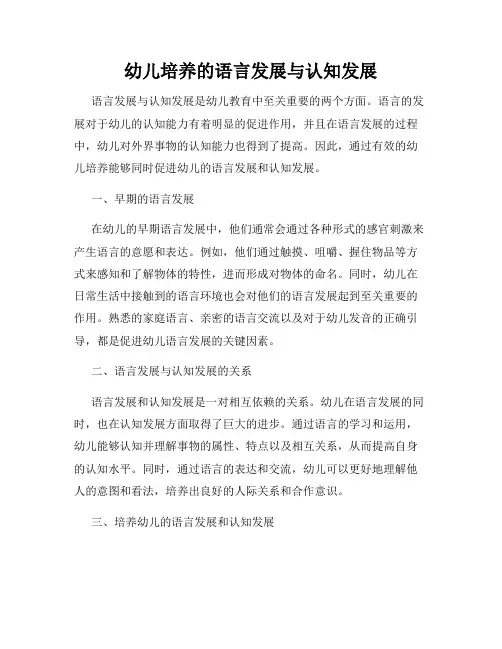
幼儿培养的语言发展与认知发展语言发展与认知发展是幼儿教育中至关重要的两个方面。
语言的发展对于幼儿的认知能力有着明显的促进作用,并且在语言发展的过程中,幼儿对外界事物的认知能力也得到了提高。
因此,通过有效的幼儿培养能够同时促进幼儿的语言发展和认知发展。
一、早期的语言发展在幼儿的早期语言发展中,他们通常会通过各种形式的感官刺激来产生语言的意愿和表达。
例如,他们通过触摸、咀嚼、握住物品等方式来感知和了解物体的特性,进而形成对物体的命名。
同时,幼儿在日常生活中接触到的语言环境也会对他们的语言发展起到至关重要的作用。
熟悉的家庭语言、亲密的语言交流以及对于幼儿发音的正确引导,都是促进幼儿语言发展的关键因素。
二、语言发展与认知发展的关系语言发展和认知发展是一对相互依赖的关系。
幼儿在语言发展的同时,也在认知发展方面取得了巨大的进步。
通过语言的学习和运用,幼儿能够认知并理解事物的属性、特点以及相互关系,从而提高自身的认知水平。
同时,通过语言的表达和交流,幼儿可以更好地理解他人的意图和看法,培养出良好的人际关系和合作意识。
三、培养幼儿的语言发展和认知发展1. 创设有益的语言环境:给予幼儿充分的语言刺激和机会,提供丰富多样的语言材料,如绘本、故事会等,以培养幼儿的听说能力和词汇量。
2. 赋予幼儿有效的语言引导:幼儿在语言发展的初期,父母和教师应提供准确的语言模型,帮助幼儿正确地学习和使用语言,引导他们逐渐掌握语音、词汇、语法等规则。
3. 注重经验的积累和实践的机会:通过亲身体验和实际操作,激发幼儿的思维和表达能力,让他们更好地理解和运用语言,提高自身的认知水平。
4. 开展语言游戏和交流活动:通过多种形式的游戏、表演、角色扮演等方式,让幼儿积极参与到语言活动中,提高他们的语言运用能力和思维能力。
5. 鼓励幼儿自主学习和探索:在语言发展和认知发展的过程中,引导幼儿主动思考、探索和解决问题,培养他们的自主学习能力和创新精神。

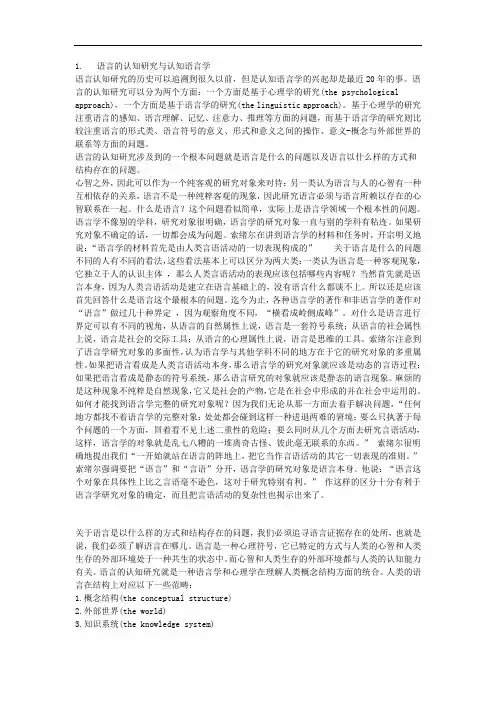
1. 语言的认知研究与认知语言学语言认知研究的历史可以追溯到很久以前,但是认知语言学的兴起却是最近20年的事。
语言的认知研究可以分为两个方面:一个方面是基于心理学的研究(the psychological approach),一个方面是基于语言学的研究(the linguistic approach)。
基于心理学的研究注重语言的感知、语言理解、记忆、注意力、推理等方面的问题,而基于语言学的研究则比较注重语言的形式类、语言符号的意义、形式和意义之间的操作、意义-概念与外部世界的联系等方面的问题。
语言的认知研究涉及到的一个根本问题就是语言是什么的问题以及语言以什么样的方式和结构存在的问题。
心智之外,因此可以作为一个纯客观的研究对象来对待;另一类认为语言与人的心智有一种互相依存的关系,语言不是一种纯粹客观的现象,因此研究语言必须与语言所赖以存在的心智联系在一起。
什么是语言?这个问题看似简单,实际上是语言学领域一个根本性的问题。
语言学不像别的学科,研究对象很明确,语言学的研究对象一直与别的学科有粘连。
如果研究对象不确定的话,一切都会成为问题。
索绪尔在讲到语言学的材料和任务时,开宗明义地说:“语言学的材料首先是由人类言语活动的一切表现构成的”关于语言是什么的问题不同的人有不同的看法,这些看法基本上可以区分为两大类:一类认为语言是一种客观现象,它独立于人的认识主体,那么人类言语活动的表现应该包括哪些内容呢?当然首先就是语言本身,因为人类言语活动是建立在语言基础上的,没有语言什么都谈不上。
所以还是应该首先回答什么是语言这个最根本的问题。
迄今为止,各种语言学的著作和非语言学的著作对“语言”做过几十种界定,因为观察角度不同,“横看成岭侧成峰”。
对什么是语言进行界定可以有不同的视角,从语言的自然属性上说,语言是一套符号系统;从语言的社会属性上说,语言是社会的交际工具;从语言的心理属性上说,语言是思维的工具。
索绪尔注意到了语言学研究对象的多面性,认为语言学与其他学科不同的地方在于它的研究对象的多重属性。
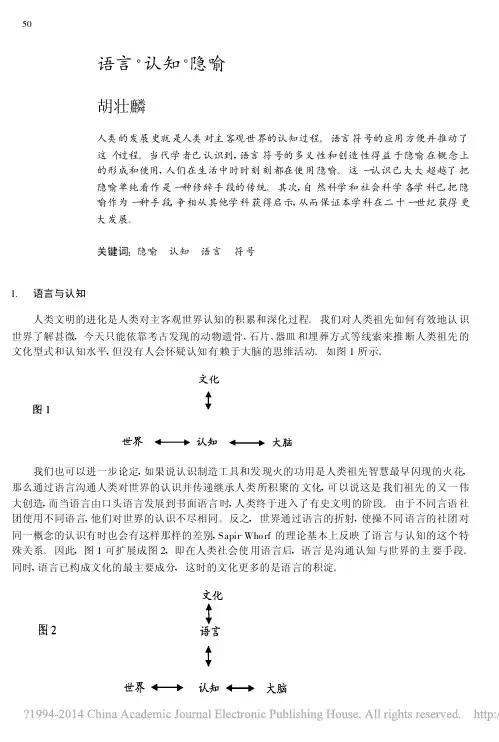
语言·认知·隐喻胡壮麟人类的发展史就是人类对主客观世界的认知过程。
语言符号的应用方便并推动了这个过程。
当代学者已认识到,语言符号的多义性和创造性得益于隐喻在概念上的形成和使用,人们在生活中时时刻刻都在使用隐喻。
这一认识已大大超越了把隐喻单纯看作是一种修辞手段的传统。
其次,自然科学和社会科学各学科已把隐喻作为一种手段,争相从其他学科获得启示,从而保证本学科在二十一世纪获得更大发展。
关键词:隐喻 认知 语言 符号1. 语言与认知人类文明的进化是人类对主客观世界认知的积累和深化过程。
我们对人类祖先如何有效地认识世界了解甚微,今天只能依靠考古发现的动物遗骨、石片、器皿和埋葬方式等线索来推断人类祖先的文化型式和认知水平,但没有人会怀疑认知有赖于大脑的思维活动。
如图1所示。
我们也可以进一步论定,如果说认识制造工具和发现火的功用是人类祖先智慧最早闪现的火花,那么通过语言沟通人类对世界的认识并传递继承人类所积聚的文化,可以说这是我们祖先的又一伟大创造,而当语言由口头语言发展到书面语言时,人类终于进入了有史文明的阶段。
由于不同言语社团使用不同语言,他们对世界的认识不尽相同。
反之,世界通过语言的折射,使操不同语言的社团对同一概念的认识有时也会有这样那样的差别,Sapir-Who rf的理论基本上反映了语言与认知的这个特殊关系。
因此,图1可扩展成图2,即在人类社会使用语言后,语言是沟通认知与世界的主要手段。
同时,语言已构成文化的最主要成分,这时的文化更多的是语言的积淀。
50中国·广州现代外语 1997年第4期(总第78期):1-16页Language,Cognition and MetaphorHu ZhuanglinT he history of mankind is a cog nitive process of understanding the world,objective and subjective.No o ne would query the unique role played by the mental activities of the human brain.If the discovery of fire and the making of tools were the earliest flashes of human intellect,the use of linguistic sig ns was one more epo ch-making invention of our fo refathers.T his enabled our ancesto rs to pass on their accumulated know l-edge from one generation to ano ther.When the linguistic signs developed from speech to w riting,man en-tered the real stag e of nguage served as a bridge between the world and cognition.How could we use languag e to know the w orld effectively?M artinet's double ar ticulation theory gave us a satisfactory answ er in the sense that multiple meaning could be ex pressed by infinite combina tio ns of sounds and monemes.As fo r the relation between verbal signs and meaning,it is the catego rization theory and the subsequent prototype theory that impar t the symbolic function to languag e.However,this is merely a picture of static depiction;a particular ideational category is realized by a particular linguistic sig n.In fact,the practical situation is much more complex as the world has been changing,and our range of cogni-tio n has been extending and deepening.Consequently,the o riginal categories could no lo nger reflect the new changing wo rld.Where do the new catego ries and new concepts come from?In the meantime,how could the original linguistic signs represent those new categories and new concepts we are now familiar with?It has been proved that the poly semy and novelty of ling uistic sig ns benefit from the creation of metaphors,which are co nventional and omnipresent in human life.T hat is to say,the traditional recogni-tio n of seeing metaphors merely as a rheto rical device is no lo nger valid.T he cataly st leading to ling uistic change is me taphorization.L anguage users metapho rize the meaning of an expression in one domain as one in another.However,it is now understoo d that linguistic metaphorization does not stand by itself.I t is a reflection of conceptual metaphorization as observed by Lakoff and Johnson.T he conventional expressions we are familiar with today are actually the sedimentation of conceptual metaphors in the past.T hus,the metaphors of the former generation became the conventional representation of the later generation.T here are several approaches to account for the distinction betw een non-metaphor and metaphor,such as the tension theory,the controversion theory,the deviance theory, and the semantic anomaly theo ry.So far consensus has no t been reached.Since linguistic metaphorizatio n results from conceptual metapho rization,it follows that it is necessary to clarify the nature of conceptual metaphorization.How is metapho r produced?How is it understood?How is it verified?It is now understood that metaphor production and comprehensio n are determined by language users'experience and imagination,which fur ther relate to language users'long-term memory,age and en-vironments.T here is a deeper and more important relation betw een metaphor and cognition.M etaphor is no long er a passive process of realizing our ever-enlarg ing know ledge.I t plays an active role in helping us fo rm new knowledg e and know the objective world deeper and better.V arious disciplines of natural sciences and social sciences have already kept an eye upon the findings of o ther disciplines by w ay of metaphorization.For in-stance,the no tion of“virus”in medical science is now metaphorized into computer science.T he notion of superhig hw ay in the sector of co mmunications is now metaphrized as info rmation highway in information science.Because of this, scientists have draw n our attention to the importance of metapho riation,which can g uide and develop various disciplines in the21st century.K eywords: metapho r, cognition, lang uage, sign 世界如此之大,人们如何利用语言来有效地认识世界呢?M ar tinet (1962)的双重分节理论作了比较满意的回答,语言形式(语音和词素)在两个层次上的组合表示各种语义。
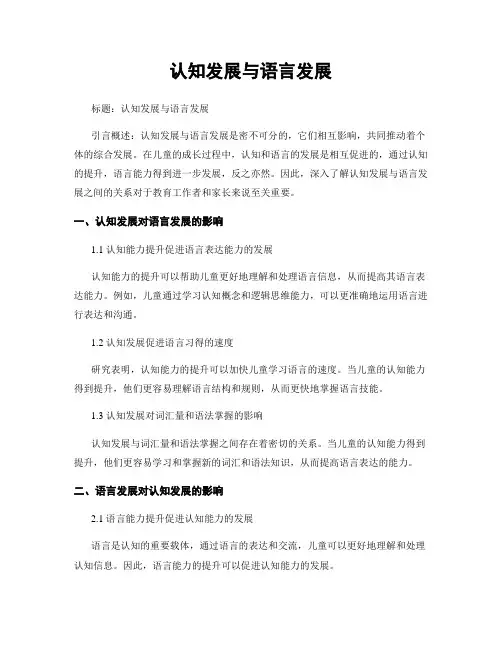
认知发展与语言发展标题:认知发展与语言发展引言概述:认知发展与语言发展是密不可分的,它们相互影响,共同推动着个体的综合发展。
在儿童的成长过程中,认知和语言的发展是相互促进的,通过认知的提升,语言能力得到进一步发展,反之亦然。
因此,深入了解认知发展与语言发展之间的关系对于教育工作者和家长来说至关重要。
一、认知发展对语言发展的影响1.1 认知能力提升促进语言表达能力的发展认知能力的提升可以帮助儿童更好地理解和处理语言信息,从而提高其语言表达能力。
例如,儿童通过学习认知概念和逻辑思维能力,可以更准确地运用语言进行表达和沟通。
1.2 认知发展促进语言习得的速度研究表明,认知能力的提升可以加快儿童学习语言的速度。
当儿童的认知能力得到提升,他们更容易理解语言结构和规则,从而更快地掌握语言技能。
1.3 认知发展对词汇量和语法掌握的影响认知发展与词汇量和语法掌握之间存在着密切的关系。
当儿童的认知能力得到提升,他们更容易学习和掌握新的词汇和语法知识,从而提高语言表达的能力。
二、语言发展对认知发展的影响2.1 语言能力提升促进认知能力的发展语言是认知的重要载体,通过语言的表达和交流,儿童可以更好地理解和处理认知信息。
因此,语言能力的提升可以促进认知能力的发展。
2.2 语言发展对思维方式的影响语言是思维的工具,通过语言的表达和交流,儿童可以更清晰地思考问题和解决问题。
语言的发展可以促进儿童的思维方式得到进一步发展和完善。
2.3 语言发展对问题解决能力的提升语言的发展可以帮助儿童更好地表达问题和解决问题的思路。
通过语言的表达和交流,儿童可以更快地理解问题的本质和找到解决问题的方法。
三、认知发展与语言发展的互动关系3.1 认知发展与语言发展是相互促进的认知发展与语言发展之间存在着相互促进的关系。
认知能力的提升可以促进语言能力的发展,而语言能力的提升也可以促进认知能力的发展。
3.2 认知发展与语言发展的互动对儿童综合发展至关重要认知发展与语言发展的互动关系对于儿童的综合发展至关重要。
![参考文献引用[1,2]](https://uimg.taocdn.com/9e792861cdbff121dd36a32d7375a417876fc174.webp)
参考文献引用[1,2]参考文献:1.李晓华,张大明.语言与认知[M].北京:北京大学出版社, 2005.2.范晔,张成亮,杨洪宾,等.认知神经科学导论[M].北京:人民出版社, 2010.概论语言和认知之间的关系引起了广泛的研究和关注。
语言是人类最为重要的交际工具之一,而认知则是人类思维和心智活动的核心。
因此,语言和认知之间的关系对于我们理解人类思维过程、语言习得和认知发展具有重要意义。
本文将综述一些重要的研究成果,探讨语言和认知之间的互动关系,并讨论这一领域未来的研究方向。
语言和认知的相互关系语言是思维的表达工具之一,通过语言我们能够将自己的思想和情感传达给他人,并从他人那里获取信息。
然而,语言与认知之间的关系并非单向的,认知也影响着我们的语言表达方式和语言理解能力。
在语言习得阶段,儿童从无语到会语的过程中,语言和认知的互动起到至关重要的作用。
李晓华和张大明的研究指出,语言习得与认知能力的发展相互依赖,语言的学习可以促进认知的发展,而认知的发展也会促进语言的学习[1]。
儿童在语言习得的过程中通过观察和模仿他人的语言行为来学习语言,这一过程依赖于他们的认知能力。
同时,语言的学习也推动了儿童认知能力的发展,通过语言的学习,儿童能够表达和组织自己的思想,这对于他们认知能力的提升至关重要。
此外,语言在思维过程中起到了重要的作用。
范晔等人的研究探讨了语言对思维的影响,他们提出了“语言相对论”的概念,认为语言结构和语言方式对于人类思维的发展和演化起到了决定性的作用[2]。
不同语言具有不同的语法结构和表达方式,这些差异会影响人们的思维方式和思维能力。
例如,一些语言中存在更多的时态和语气的变化,因此说这些语言的人更加注重时间的概念和表达,这从侧面反映了语言对于人类思维的影响。
未来的研究方向虽然在语言和认知之间的关系上已经取得了一些重要的研究成果,但仍然存在许多未解之谜。
未来的研究可以从以下几个方面进行探索。
首先,我们可以进一步研究语言学习对于认知能力的影响。
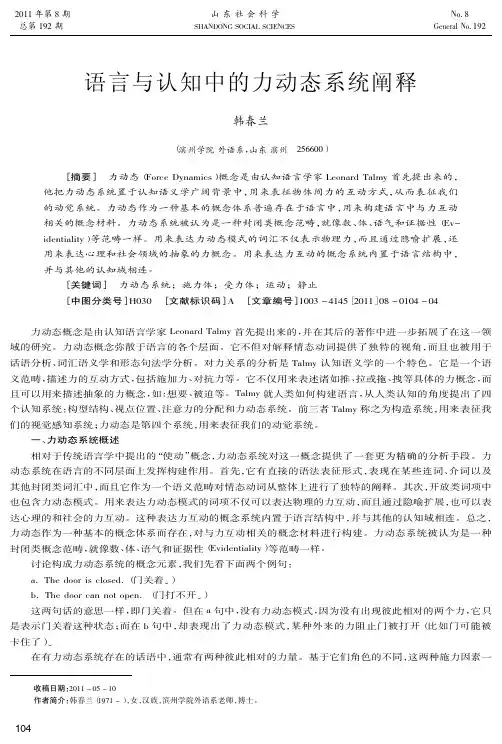
2011年第8期山东社会科学No.8总第192期SHANDONG SOCIAL SCIENCES General No.192语言与认知中的力动态系统阐释韩春兰(滨州学院外语系,山东滨州256600)[摘要]力动态(Force Dynamics)概念是由认知语言学家Leonard Talmy首先提出来的,他把力动态系统置于认知语义学广阔背景中,用来表征物体间力的互动方式,从而表征我们的动觉系统。
力动态作为一种基本的概念体系普遍存在于语言中,用来构建语言中与力互动相关的概念材料。
力动态系统被认为是一种封闭类概念范畴,就像数、体、语气和证据性(Ev-identiality)等范畴一样。
用来表达力动态模式的词汇不仅表示物理力,而且通过隐喻扩展,还用来表达心理和社会领域的抽象的力概念。
用来表达力互动的概念系统内置于语言结构中,并与其他的认知域相连。
[关键词]力动态系统;施力体;受力体;运动;静止[中图分类号]H030[文献标识码]A[文章编号]1003-4145[2011]08-0104-04力动态概念是由认知语言学家Leonard Talmy首先提出来的,并在其后的著作中进一步拓展了在这一领域的研究。
力动态概念弥散于语言的各个层面。
它不但对解释情态动词提供了独特的视角,而且也被用于话语分析、词汇语义学和形态句法学分析。
对力关系的分析是Talmy认知语义学的一个特色。
它是一个语义范畴,描述力的互动方式,包括施加力、对抗力等。
它不仅用来表述诸如推、拉或拖、拽等具体的力概念,而且可以用来描述抽象的力概念,如:想要、被迫等。
Talmy就人类如何构建语言,从人类认知的角度提出了四个认知系统:构型结构、视点位置、注意力的分配和力动态系统。
前三者Talmy称之为构造系统,用来表征我们的视觉感知系统;力动态是第四个系统,用来表征我们的动觉系统。
一、力动态系统概述相对于传统语言学中提出的“使动”概念,力动态系统对这一概念提供了一套更为精确的分析手段。
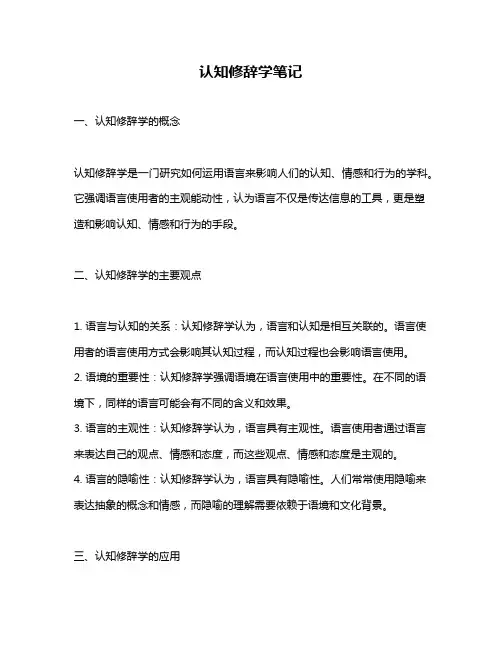
认知修辞学笔记一、认知修辞学的概念认知修辞学是一门研究如何运用语言来影响人们的认知、情感和行为的学科。
它强调语言使用者的主观能动性,认为语言不仅是传达信息的工具,更是塑造和影响认知、情感和行为的手段。
二、认知修辞学的主要观点1. 语言与认知的关系:认知修辞学认为,语言和认知是相互关联的。
语言使用者的语言使用方式会影响其认知过程,而认知过程也会影响语言使用。
2. 语境的重要性:认知修辞学强调语境在语言使用中的重要性。
在不同的语境下,同样的语言可能会有不同的含义和效果。
3. 语言的主观性:认知修辞学认为,语言具有主观性。
语言使用者通过语言来表达自己的观点、情感和态度,而这些观点、情感和态度是主观的。
4. 语言的隐喻性:认知修辞学认为,语言具有隐喻性。
人们常常使用隐喻来表达抽象的概念和情感,而隐喻的理解需要依赖于语境和文化背景。
三、认知修辞学的应用1. 广告语言:广告语言是认知修辞学的一个重要应用领域。
广告商通过运用各种语言手段来影响消费者的认知、情感和行为,以达到推销产品的目的。
2. 政治演讲:政治家在演讲中运用认知修辞学来影响听众的认知、情感和行为,以达到宣传政治理念、争取选民的目的。
3. 教育领域:教育者可以通过运用认知修辞学来提高教学效果,帮助学生更好地理解和掌握知识。
4. 媒体报道:媒体在报道新闻时,也需要运用认知修辞学来选择合适的语言和表达方式,以影响读者的认知和情感。
四、总结认知修辞学是一门具有重要意义的学科,它为我们提供了理解语言使用的新视角。
通过学习认知修辞学,我们可以更好地理解语言在人类社会中的作用,以及如何运用语言来影响他人的认知、情感和行为。
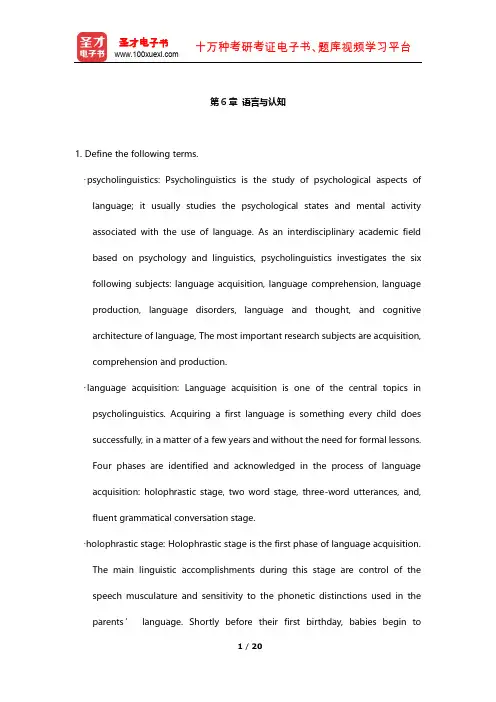
第6章语言与认知1. Define the following terms.·psycholinguistics: Psycholinguistics is the study of psychological aspects of language; it usually studies the psychological states and mental activity associated with the use of language. As an interdisciplinary academic field based on psychology and linguistics, psycholinguistics investigates the six following subjects: language acquisition, language comprehension, language production, language disorders, language and thought, and cognitive architecture of language, The most important research subjects are acquisition, comprehension and production.·language acquisition: Language acquisition is one of the central topics in psycholinguistics. Acquiring a first language is something every child does successfully, in a matter of a few years and without the need for formal lessons.Four phases are identified and acknowledged in the process of language acquisition: holophrastic stage, two word stage, three-word utterances, and, fluent grammatical conversation stage.·holophrastic stage: Holophrastic stage is the first phase of language acquisition.The main linguistic accomplishments during this stage are control of the speech musculature and sensitivity to the phonetic distinctions used in the parents’language. Shortly before their first birthday, babies begin tounderstand words, and around that birthday, they start to produce them. At this stage, words are usually produced in isolation; this one-word stage can last from two months to a year. About half the words are for objects: food, body parts, clothing, vehicles, toys, household items, animals. There are words for actions, motions, and routines.·two-word stage: Two-word stage is the second phase of language acquisition. Around 18 months, the child begins to learn words at a rate of one every two waking hours, and keeps learning that rate or faster through adolescence. The primitive syntax begins with two- word strings. Children announce when objects appear, disappear, and move about, point out their properties and owners, comment on people doing things and seeing things, reject and request objects and activities, and ask about who, what, and where. These sequences already reflect the language being acquired: in 95% of them, the words are properly ordered.·three-word utterances: Three-word utterances stage is the third phase of language acquisition. Three-word utterances look like samples drawn from longer potential sentences expressing a complete and more complicated idea. For example, although the children never produced a sentence as complicated as Mother gave John lunch in the kitchen, they did produce strings containing all of its components in the correct order.·connectionism: With respect to language comprehension, connectionism in psycholinguistics claims that readers use the same system of links betweenspelling units and sound units to generate the pronunciations of written words and to access the pronunciations of familiar words, or words that are exceptions to these patterns. In this view, similarity and frequency play important roles in processing and comprehending language, with the novel items being processed based on their similarity to the known ones.·cohort model: The cohort model is a supposed doctrine dealing with the spoken word recognition postulated by Marslen-Wilson and Welsh in 1990. It is suggested that the first few phonemes of a spoken word activate a set or cohort of word candidates that are consistent with the input. These candidates compete with one another for activation. As more acoustic input is analyzed, candidates that are no longer consistent with the input drop out of the set. This process continues until only one word candidate matches the input~ the best fitting word may be chosen if no single candidate is a clear winner. ·interactive model: The interactive model holds that in recognizing the spoken words higher processing levels have a direct, “top down”influence on lower levels. Lexical knowledge can affect the perception of phonemes. There is interactivity in the form of lexical effects on the perception of sublcxical units. In certain cases, listeners’knowledge of words can lead to the inhibition of certain phonemes; in other cases, listeners continue to “hear”phonemes that have been removed from the speech signal and replaced by noise.·race model: The race model suggests in spoken word recognition there are two routes that race each other--a pre-lexical route, which computes phonologicalinformation from the acoustic signal, and a lexical route, in which the phonological information associated with a word becomes available when the word itself is accessed. When word-level information appears to affect a lower-level process, it is assumed that the lexical route won the race. ·serial model: Serial model proposes that the sentence comprehension system continually and sequentially follows the constraints of a language’s grammar with remarkable speed. Serial model describes how the processor quickly constructs one or more representations of a sentence based on a restricted range of information that is guaranteed to be relevant to its interpretation, primarily grammatical information. Any such representation is then quickly interpreted and evaluated, using the full range of information that might be relevant.·parallel model: Parallel model emphasizes that the comprehension system is sensitive to a vast range of information, including grammatical, lexical, and contextual, as well as knowledge of the speaker/writer and of the world in general Parallel model describes how the processor uses all relevant information to quickly evaluate the full range of possible interpretations of a sentence. It is generally acknowledged that listeners and readers integrate grammatical and situational knowledge in understanding a sentence. ·resonance model: The resonance model is a model about text comprehension, in this model, information in long term memory is automatically activated by the presence of material that apparently bears a rough semantic relation to it.Semantic details, including factors such as negation that drastically change the truth of propositions, do not seem to affect the resonance process. It emphasized a more active and intelligent search for meaning as the basis by which a reader discovers the conceptual structure of a discourse. In reading a narrative text, reader attempts to build a representation of the causal structure of the text, analyzing events in terms of goals, actions, and reactions. A resonance process serves as a first stage in processing a text, and, reading objectives and details of text structure determine whether a reader goes further and searches for a coherent structure for the text.·construal: Construal is the ability to conceive and portray the same situation in alternate ways through specificity, different mental scanning, directionality, vantage point, figure-ground segregation etc.·construal operations: Construal operations are conceptualizing processes used in language process by human beings. That is, construal operations are the underlying psychological processes and resources employed in the interpretation of linguistic expressions.·figure-ground alignment: Figure-ground alignment seems to apply to space with the ground as the prepositional object and the preposition expressing the spatial relational configuration. It also applies to human perception of moving objects. Since the moving object is typically the most prominent one, because it is moving, it is typically the figure, while the remaining stimuli constitute the ground.·trajector: Trajector means a moving or dynamic figure.·landmark: Landmark means the ground provided for a moving figure.·basic level category: Basic level category is the most economical level at which you can find the most relevant information. The information on our interactions with objects in the real world are stored at this level. It is at this level that we conjure up the general gestalt of the category.·subordinate level Subordinate level is the level at which we perceive the differences between the members of the basic level categories.·image schema: Image schema is a recurring, dynamic pattern of our perceptual’interactions and motor programs that gives coherence and structure to oar experience.·metaphor: Metaphor involves the comparison of two concepts in that one is construed in terms of the other. It’s often described in terms of a target domain and a source domain. The target domain is the experience being described by the metaphor and the source domain is the means that We use in order to describe the experience.·metonymy: Metonymy is a figure of speech that has to do with the substitution of the name of one thing for that of another.·ontological metaphors: Ontological metaphors mean that human experiences with physical objects provide the basis for ways of viewing events, activities, emotions, ideas, etc., as entities and substances.·structural metaphors: Structural metaphors play the most important role。
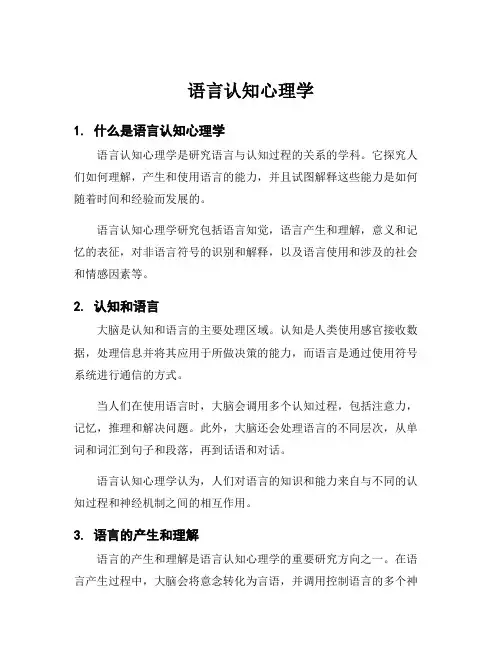
语言认知心理学1. 什么是语言认知心理学语言认知心理学是研究语言与认知过程的关系的学科。
它探究人们如何理解,产生和使用语言的能力,并且试图解释这些能力是如何随着时间和经验而发展的。
语言认知心理学研究包括语言知觉,语言产生和理解,意义和记忆的表征,对非语言符号的识别和解释,以及语言使用和涉及的社会和情感因素等。
2. 认知和语言大脑是认知和语言的主要处理区域。
认知是人类使用感官接收数据,处理信息并将其应用于所做决策的能力,而语言是通过使用符号系统进行通信的方式。
当人们在使用语言时,大脑会调用多个认知过程,包括注意力,记忆,推理和解决问题。
此外,大脑还会处理语言的不同层次,从单词和词汇到句子和段落,再到话语和对话。
语言认知心理学认为,人们对语言的知识和能力来自与不同的认知过程和神经机制之间的相互作用。
3. 语言的产生和理解语言的产生和理解是语言认知心理学的重要研究方向之一。
在语言产生过程中,大脑会将意念转化为言语,并调用控制语言的多个神经网络。
语言的理解则涉及对语言的各个方面的准确处理,包括拼写,语音,语法和语义。
此外,语言的产生和理解还涉及与情境相关的因素,例如,语言使用的目的,以及听众的前提知识和期望。
这些情境因素可以影响语言的表达和理解方式。
4. 语言的意义和表征另一个重要的研究方向是语言的意义和表征。
语言的意义与人们思维和记忆的表征密切相关,涉及到词汇和句子的意义和结构,以及如何将这些意义和结构编码和存储在大脑中。
在语言中,意义通过词汇和语法表征,这些表征是将外界信息映射到大脑中对应的符号的方式。
人们可以通过语言的不同表征来理解不同层次的语言结构,例如单词,短语,句子,段落和文本。
5. 语言的发展语言认知心理学还关注人们在其发展过程中如何学习和掌握语言的过程。
研究表明,人们在学习语言时使用了一系列的认知和神经机制,从识别音节到形成句子和撰写复杂文章。
在儿童语言发展的早期阶段,他们需要学会识别和产生声音,理解和使用单词,建立语法和意义的认识,以及适应不同的语音和口音。
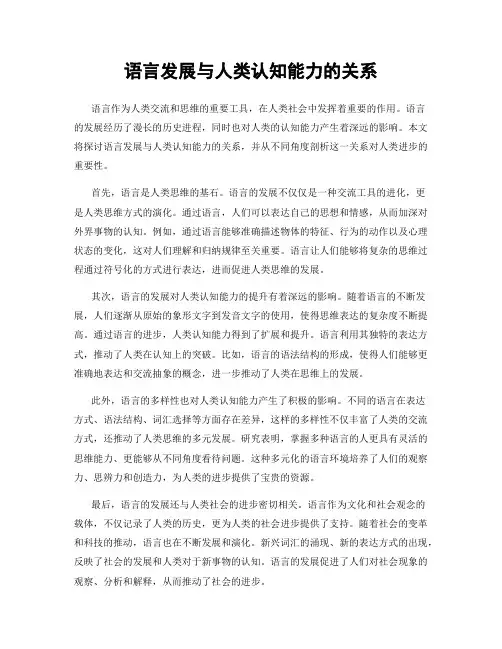
语言发展与人类认知能力的关系语言作为人类交流和思维的重要工具,在人类社会中发挥着重要的作用。
语言的发展经历了漫长的历史进程,同时也对人类的认知能力产生着深远的影响。
本文将探讨语言发展与人类认知能力的关系,并从不同角度剖析这一关系对人类进步的重要性。
首先,语言是人类思维的基石。
语言的发展不仅仅是一种交流工具的进化,更是人类思维方式的演化。
通过语言,人们可以表达自己的思想和情感,从而加深对外界事物的认知。
例如,通过语言能够准确描述物体的特征、行为的动作以及心理状态的变化,这对人们理解和归纳规律至关重要。
语言让人们能够将复杂的思维过程通过符号化的方式进行表达,进而促进人类思维的发展。
其次,语言的发展对人类认知能力的提升有着深远的影响。
随着语言的不断发展,人们逐渐从原始的象形文字到发音文字的使用,使得思维表达的复杂度不断提高。
通过语言的进步,人类认知能力得到了扩展和提升。
语言利用其独特的表达方式,推动了人类在认知上的突破。
比如,语言的语法结构的形成,使得人们能够更准确地表达和交流抽象的概念,进一步推动了人类在思维上的发展。
此外,语言的多样性也对人类认知能力产生了积极的影响。
不同的语言在表达方式、语法结构、词汇选择等方面存在差异,这样的多样性不仅丰富了人类的交流方式,还推动了人类思维的多元发展。
研究表明,掌握多种语言的人更具有灵活的思维能力、更能够从不同角度看待问题。
这种多元化的语言环境培养了人们的观察力、思辨力和创造力,为人类的进步提供了宝贵的资源。
最后,语言的发展还与人类社会的进步密切相关。
语言作为文化和社会观念的载体,不仅记录了人类的历史,更为人类的社会进步提供了支持。
随着社会的变革和科技的推动,语言也在不断发展和演化。
新兴词汇的涌现、新的表达方式的出现,反映了社会的发展和人类对于新事物的认知。
语言的发展促进了人们对社会现象的观察、分析和解释,从而推动了社会的进步。
综上所述,语言的发展与人类认知能力具有密不可分的关系。
现实.认知.语言认知和语言都是基于对现实的体验之上的,认知先于语言、决定语言,是语言的基础;语言又可反作用于认知,可促进认知的发展和完善,语言与认知相互作用、相互影响、紧密联系。
标签:认知语言现实认知是人类的基本机能之一,认知的核心问题是思维,认知的表达形式是概念,认知的中心过程是推理;语言是承载思维、表达概念、运行推理的重要工具。
因此,认知和语言的关系是一个非常重要且有意义的研究课题。
(卢植,2006:vii)按照认知语言学经验主义的哲学观和语言观,语言既是一种认知活动,又是以认知为基础的;而认知和语言不能脱离人的身体构造,不能脱离我们赖以生存的物质世界,也不能脱离人的认知能力和认知的组织作用。
语言是人类认知活动的产物和工具,因此其结构和功能也应被看成是人类一般认知活动的结果和反映。
认知和语言都是基于对现实的体验之上的,认知先于语言、决定语言,是语言的基础;语言又可反作用于认知,可促进认知的发展和完善,语言与认知相互作用、相互影响、紧密联系。
昔日的语言研究多重视语言形式、结构、内部关系的描写,或强调语言与客观世界的对应,而没有从认知角度将主观与客观结合起来深入解释语言,这是认知语言学不同于许多其他学派的根本区别之一。
(王寅,2007:32)一、认知认知语言学里的“认知”一词是相对“形式”而言的。
认知(cognition)一词源于拉丁语cognitio,是心理学研究的重要领域之一,指人获得知识或学习的过程,是人的大脑理解和认识事物的行为与能力。
“认知最简单的定义是知识的习得和使用,它是一个内在的心理过程,因而是有目的的,可以控制的。
知识习得和使用牵涉到诸如感知觉、型式识别、视觉表象、注意、记忆、知识结构、语言、思维、决策、解决问题等等心理表征在内心里的操作,从‘白日做梦’到为了解决问题而进行的抽象思维,都可包括在内。
”(桂诗春,2004:14)认知语言学中的“认知”具有特殊的涵义,这不仅是因为它的认知承诺,而且更是由于它积极寻找在概念思维、身体经验和语言结构之间的对应关系,以及发现人类认知或概念知识的实际内容。
认知语言学外语教育学(一)引言概述:认知语言学是研究语言与认知关系的学科,它为外语教育提供了新的理论视角和方法。
本文通过几个大点来探讨认知语言学在外语教育学中的应用。
首先,我们将介绍认知语言学的基本概念和理论框架。
然后,我们将详细讨论认知语言学对外语教学的影响,包括其在词汇教学、语法教学、听力和口语训练以及写作教学中的应用。
最后,我们将总结认知语言学对外语教育学的重要意义,以及未来的发展方向。
正文:1. 认知语言学的基本概念和理论框架- 描述认知语言学的定义和目标- 解释认知语言学的理论框架,如心理语言学和语言认知处理等- 探讨认知语言学与其他学科的关系,如心理学、神经科学等2. 认知语言学在词汇教学中的应用- 分析词汇认知的过程和机制- 探讨词汇教学中的认知策略,如语义网络、联想记忆等- 讨论认知语言学对词汇教学的影响和启示3. 认知语言学在语法教学中的应用- 阐述语法认知的概念和特点- 讨论认知语法教学的策略和方法,如意义导向教学、概念映射等- 总结认知语言学对语法教学的价值和意义4. 认知语言学在听力和口语训练中的应用- 分析听力和口语认知的过程和特点- 探讨认知语言学对听力解码和口语产出的影响- 讨论认知语言学在听力和口语训练中的策略和方法,如认知负荷理论、语篇分析等5. 认知语言学在写作教学中的应用- 阐述写作认知的过程和特点- 探讨认知语言学对写作教学的影响和启示- 讨论认知语言学在写作教学中的策略和方法,如思维导图、意义导向写作等总结:认知语言学作为一门研究语言与认知关系的学科,对外语教育学具有重要影响。
通过认知语言学的理论框架,可以更好地理解词汇、语法、听力、口语和写作等方面的教学。
词汇教学可以通过认知语言学的认知策略提高学生的词汇记忆和运用能力;语法教学可以通过认知语言学的方法帮助学生理解和运用语法知识;听力和口语训练可以借鉴认知语言学的认知负荷理论来提高学生的听说能力;写作教学可以通过认知语言学的策略和方法来培养学生的写作思维。
语言与思维一、语言与思维的界定语言是交际的工具,它是一种社会现象。
它是由声音(语音)、词汇和语法各个部分构成的,语言在实现它的交际功能时,正是它的三个构成部分的综合应用。
言语是指个体对语言的掌握和运用的过程。
它是一种心理现象。
言语,这是语言在交际过程中的运用,利用同一种语言,可以说出大量的、各种不同的言语。
思维是人类大脑能动地反映客观现实的过程,是人类开动脑筋认识世界的过程中进行比较、分析、综合的能力,是人类大脑的一种机能。
思维是复杂的,多形态的,一个人同时并存着几种不同形态的高度发达的思维。
一般把思维分为三种类型:1.直观动作思维:这种思维指思维时能直接感知思维对象,并通过思维者自身的动作去影响思维对象的那样一种思维活动。
例如像工程设计师、体育运动员等的思维活动都具有直观动作特点,教练员讲解有关体育战术如足球、篮球、排球等也要用直观思维。
2.形象思维:这种思维指在思维时用唤起形象并在想象中对形象进行加工改造的那样一种思维活动人。
艺术家和文学家思维时(在进行艺术构思时)就充分地进行着这种形象的加工改造和组合的活动。
比如构思一幅画、一座雕塑、一个情节、一个戏剧场景等,都要进行形象思维。
3.抽象思维:也叫逻辑思维,指人们对客观事物进行抽象概括分类,形成概念,并运用概念进行判断和推理的那样一种思维活动。
通常我们所说的思维、思维能力,主要地是指这种思维,是人类最普遍的一种思维类型。
这种思维只有人类有,动物没有,所以动物没有语言。
有人曾经做过试验,把小鸡抓住捆扎起来,小鸡挣扎尖叫,母鸡会应声而至,赶来营救;而把小鸡罩在玻璃瓶中,哪怕小鸡挣扎喊破了嗓子,母鸡因为听不倒小鸡的叫声,在一边仍然是无动于衷,若无其事,这说明母鸡只有第一信号系统,只具有直观思维能力,没有逻辑思维能力。
这三种类型的思维活动,语言在其中的作用是不相同的。
前两种思维很少语言的活动,一般称为非语言思维,第三种思维主要依靠语言进行,所以是语言思维。
认知心理学中的认知语言学和对比语言学在认知心理学中,认知语言学和对比语言学是两个非常重要的分支,它们帮助我们更好地理解和研究人类语言能力和思维过程。
一、认知语言学认知语言学是一种研究人类语言能力和思维过程的学科,它主要关注的是人们使用语言进行思考和表达的过程。
认知语言学从认知心理学的角度探讨语言的本质,旨在了解人类语言能力的神经基础和认知机制。
1.1 语音知觉人类语言的一个重要方面是语音,而语音的知觉过程是如何实现的呢?认知语言学家通过实验发现,人们在听取语音时通常会将其分解为语音的不同部分,比如音位和音节。
1.2 语义和句法语言的另一个关键方面是语义和句法。
认知语言学家认为,人类语言能力的核心是语法,在语法的帮助下,人们能够产生无限的、合乎语法的句子。
语义则是指句子的意义,它包括单词之间的关系、上下文以及语言中的语音、触感、视觉和其他感官信号。
1.3 语言习得语言习得是认知语言学中的一个重要研究方向。
该领域的研究主要关注儿童语言习得过程中的认知机制和发展趋势。
二、对比语言学对比语言学则是以比较的方式研究语言,通过比较不同语言之间的差异和相似之处,来揭示语言的共性和个性。
相比于认知语言学而言,对比语言学更注重语言的文化因素以及语言与文化的相互联系。
2.1 语言的分类对比语言学的第一步是语言的分类。
语言可以按照某些特征分类,比如语音、语法、词汇等。
通常认为,语言可以分为语系、语族和语种。
语系是指互相间有关联的语言,如印欧语系、汉藏语系等。
语族则是指具有同一祖先语的语言,如日耳曼语族、斯拉夫语族等。
语种则是指特定语言的不同形态,如英语、德语、法语等。
2.2 语言的结构对比语言学主要关注语言的结构。
语言结构包括语音、词汇、语法等方面,每种语言都有其独特的结构。
比如,中国话与英语在语音方面的差异就很大,这导致两种语言都有独特的语音系统和特有的音素。
2.3 语言与文化对比语言学的另一个重要研究方向是语言与文化之间的关系。
小班语言教学中的幼儿发展与认知培养幼儿发展与认知培养在小班语言教学中起着至关重要的作用。
通过恰当的教学方法和活动设计,可以促进幼儿的语言能力、认知能力和综合素养的全面提升。
本文将探讨小班语言教学中如何有效地促进幼儿的发展与认知培养。
一、关注幼儿语言发展语言是幼儿认知和沟通的重要工具,因此,在小班语言教学中,教师应该注重培养幼儿的语言能力。
首先,教师可以通过丰富的语言输入,帮助幼儿掌握丰富的词汇和语法结构。
例如,在日常教学中,教师可以利用各种教具和游戏,生动有趣地向幼儿传递语言知识。
此外,教师还应该引导幼儿参与到语境中,通过真实的情景体验和互动交流,提升幼儿的语言运用能力。
二、培养幼儿的思维能力小班语言教学中的活动设计应该注重培养幼儿的思维能力。
幼儿期是思维发展的关键时期,因此,通过合适的活动可以激发幼儿的思维潜能。
例如,幼儿可以通过角色扮演、故事讲解等活动,培养自己的观察力、联想力和想象力。
同时,教师还应该引导幼儿进行一些简单的问题解决和判断推理活动,提升他们的逻辑思维能力。
三、注重培养幼儿的学习兴趣在小班语言教学中,教师应该通过创设良好的学习环境,培养幼儿的学习兴趣。
学习兴趣是推动幼儿主动学习和探索的动力。
因此,教师可以通过多样化的教学资源和活动,让幼儿在轻松愉悦的氛围中获得学习的乐趣。
例如,可以组织有趣的游戏、拓展性实践活动和音乐、舞蹈等主题活动,激发幼儿的兴趣,激发他们的学习潜能。
四、尊重幼儿的个体差异在小班语言教学中,幼儿的个体差异不可忽视。
不同的幼儿在语言能力和认知发展方面存在差异,因此,教师应该根据幼儿的个体特点和发展水平,采用差异化教学策略。
例如,针对语言基础较差的幼儿,可以采取渐进式的教学方法,循序渐进地帮助他们提升语言能力。
对于认知能力较强的幼儿,可以提供更深入的学习内容,激发他们的思维反应和创新能力。
总之,小班语言教学中的幼儿发展与认知培养是一个综合性的过程,需要教师的精心设计和引领。